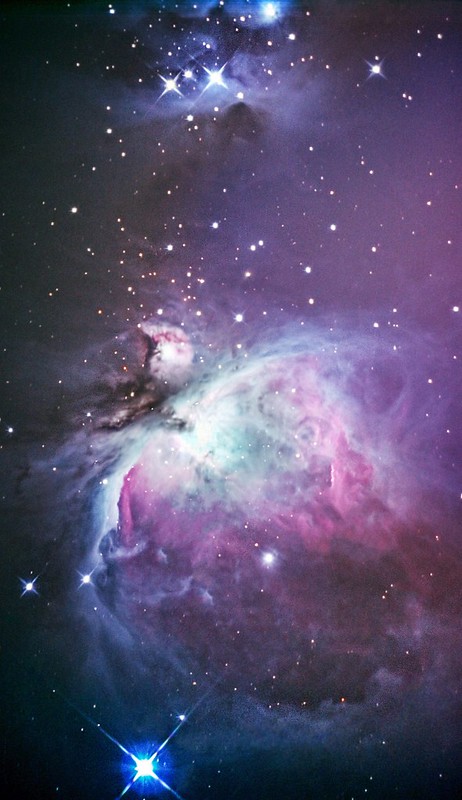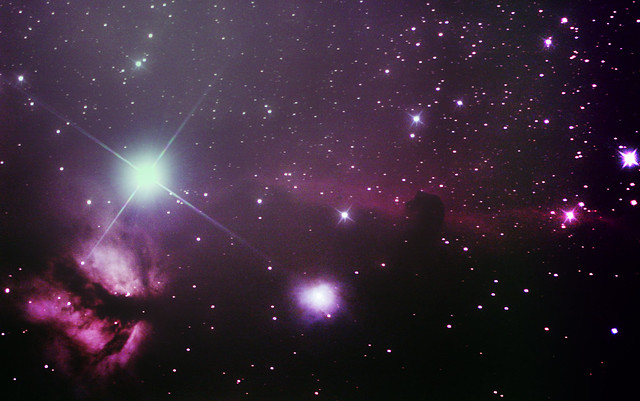A) The Sword of Orion, featuring the Running Man nebula (NGC 1973/5/7) to the top and the Great Nebula in Orion (M42/NGC 1976) to the bottom.
Photographic Information:
Imaging location: Thomson, Singapore (Light pollution: White zone/Inner City)
Date of data acquisition: 31 January 2014
Exposure Details: ~45min, 800mm FL at f/4
Camera: Canon EOS 600D Unmodified
Stacked with DSS, adjustment of curves and colors in Adobe Photoshop CS6.
Description:
The term 'nebula' is a very generic term that can mean quite a number of things. The word 'nebula' actually originated from the latin word for 'cloud', and can therefore be used on almost any astronomical object that appears fuzzy looking. In this case, however, it means something much more specific, and that is a stellar nursery; a place where stars are born.
In this image, vast swaths of blue and red cover the image, and these represent giant clouds of gas and dust. Quite literally, what you are looking at is stardust - stardust which form the ingredients that future stars are made of.
The blue coloration in the image originates from starlight coming from the bright young stars reflecting off the nebula. Most of the stars here are O-class stars, which are the largest, brightest and hottest stars in the Universe. The intense light emitted by these stars reflect off the diffuse hydrogen clouds, giving a soft bluish glow.
On the other hand, the red coloration represents something more interesting. O-class stars, with surface temperatures ranging tens of thousands of degrees, emit copious amounts of high energy ionizing radiation. Large amounts of ultraviolet light strip away the electrons from the interstellar hydrogen, leaving behind its positive nucleus. As the electrons recombine with the nuclei to re-form atomic hydrogen, it passes through a series of energetic transitions. Because of the distinct energy gaps between electron shells, the wavelength of light emitted during these transitions is the same. One such transition, in which the electron drops from the third energy level to the second closest to the nuclei, produces a very precise wavelength of light. This emission line is known as hydrogen alpha (HA), and produces red light at exactly 656.281 nanometers.
The importance of hydrogen alpha emissions is that it gives us an idea of the composition of nebulae. When large amounts of HA is emitted, it implies that large amounts of atomic hydrogen exist in the nebula. Atomic hydrogen is important because it forms the main ingredient that triggers star formation.
Even despite imaging from close to the heart of a highly light-polluted city, details of the outer nebulosity are visible. Exceptional weather conditions, as well as taking as many sub-exposures as possible, contribute to pulling out faint detail in astrophotography.
B) The Alnitak Region in Orion, featuring the Flame Nebula, Horsehead Nebula, and of course, the star Alnitak.
Photographic Information:
Date of data acquisition: 31 January 2014
Exposure Details: ~30min, 800mm FL at f/4
Camera: Canon EOS 350D Modified (IR Filter removed)
Stacked with DSS, adjustment of curves and colors in Adobe Photoshop CS6.
Description:
The Flame nebula and Horsehead nebula, like the Orion nebula above, is a diffuse nebula where stars are born. Unlike the Orion nebula, however, the Flame and Horsehead undergo very little reflection nebulosity. The main emission line coming from these two nebulae are from Hydrogen Alpha, which gives it the characteristic red hue. Due to the colour processing however, the hue is shifted towards magenta rather than its true colour.
The bright star in this picture is Alnitak, one of the brightest stars in the sky, and the westernmost star of Orion's belt. Like the young stars in the Great Orion Nebula, Alnitak is a massive O-class star, producing violent amounts of ionising radiation. The relentless burst of energy from Alnitak is what drives the incandescent nebulosity of the Flame nebula.
The horsehead nebula is actually an absorption (dark) nebula, silhouetted against the soft glow of an emission nebula. Without this 'curtain' that lights up from behind, we wouldn't be able to see the horsehead in visible light. Even then, the horsehead is typically regarded as a challenging astronomical object to see and image because of its dimness.
In order to bring out the horsehead, especially from such a highly light polluted region, a modified DSLR camera has to be used. Because the hydrogen alpha line in the visible spectrum lies so close to the infrared, unmodified DSLRs are very insensitive to such wavelengths, as are the human eyes. As such, the removal of the in-built UV/IR filters and its subsequent replacement with a clear glass plate will bring up the sensitivity of the sensor to these wavelengths, allowing the horsehead to appear.

